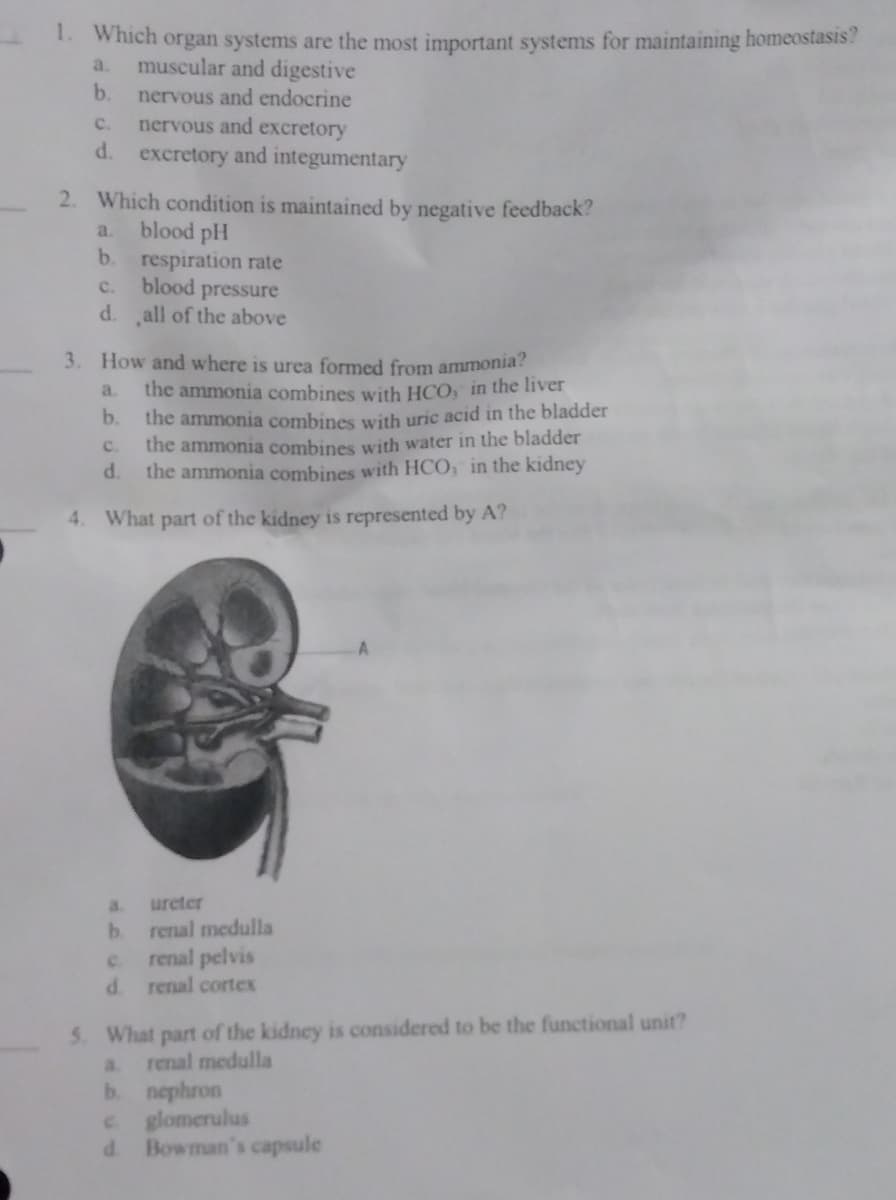1. Which organ systems are the most important systems for maintaining homeostasis? muscular and digestive nervous and endocrine C. nervous and excretory d. excretory and integumentary a. b. 2. Which condition is maintained by negative feedback? blood pH a. b. C. d. 3. How and where is urea formed from ammonia? the ammonia combines with HCO, in the liver the ammonia combines with uric acid in the bladder the ammonia combines with water in the bladder the ammonia combines with HCO, in the kidney 4. What part of the kidney is represented by A? a. b. C. d. respiration rate blood pressure all of the above a. b. ureter renal medulla renal pelvis d. renal cortex 5. What part of the kidney is considered to be the functional unit? renal medulla a. b. nephron c. glomerulus d Bowman's capsule
1. Which organ systems are the most important systems for maintaining homeostasis? muscular and digestive nervous and endocrine C. nervous and excretory d. excretory and integumentary a. b. 2. Which condition is maintained by negative feedback? blood pH a. b. C. d. 3. How and where is urea formed from ammonia? the ammonia combines with HCO, in the liver the ammonia combines with uric acid in the bladder the ammonia combines with water in the bladder the ammonia combines with HCO, in the kidney 4. What part of the kidney is represented by A? a. b. C. d. respiration rate blood pressure all of the above a. b. ureter renal medulla renal pelvis d. renal cortex 5. What part of the kidney is considered to be the functional unit? renal medulla a. b. nephron c. glomerulus d Bowman's capsule
Biology: The Dynamic Science (MindTap Course List)
4th Edition
ISBN:9781305389892
Author:Peter J. Russell, Paul E. Hertz, Beverly McMillan
Publisher:Peter J. Russell, Paul E. Hertz, Beverly McMillan
Chapter48: Regulating The Internal Environment
Section: Chapter Questions
Problem 2TYK
Related questions
Question
Can you fill in the correct multiple choice options.

Transcribed Image Text:1. Which organ systems are the most important systems for maintaining homeostasis?
a.
muscular and digestive
b.
nervous and endocrine
nervous and excretory
excretory and integumentary
C.
d.
2. Which condition is maintained by negative feedback?
blood pH
respiration rate
blood pressure
all of the above
a.
b.
C.
d.
3. How and where is urea formed from ammonia?
a. the ammonía combines with HCO, in the liver
the ammonia combines with uric acid in the bladder
the ammonia combines with water in the bladder
the ammonia combines with HCO, in the kidney
b.
4. What part of the kidney is represented by A?
C.
d.
a. ureter
b.
renal medulla
renal pelvis
d. renal cortex
5. What part of the kidney is considered to be the functional unit?
a renal medulla
b. nephron
d
glomerulus
Bowman's capsule
Expert Solution
This question has been solved!
Explore an expertly crafted, step-by-step solution for a thorough understanding of key concepts.
This is a popular solution!
Trending now
This is a popular solution!
Step by step
Solved in 2 steps with 1 images

Knowledge Booster
Learn more about
Need a deep-dive on the concept behind this application? Look no further. Learn more about this topic, biology and related others by exploring similar questions and additional content below.Recommended textbooks for you

Biology: The Dynamic Science (MindTap Course List)
Biology
ISBN:
9781305389892
Author:
Peter J. Russell, Paul E. Hertz, Beverly McMillan
Publisher:
Cengage Learning


Essentials of Pharmacology for Health Professions
Nursing
ISBN:
9781305441620
Author:
WOODROW
Publisher:
Cengage

Biology: The Dynamic Science (MindTap Course List)
Biology
ISBN:
9781305389892
Author:
Peter J. Russell, Paul E. Hertz, Beverly McMillan
Publisher:
Cengage Learning


Essentials of Pharmacology for Health Professions
Nursing
ISBN:
9781305441620
Author:
WOODROW
Publisher:
Cengage

Medical Terminology for Health Professions, Spira…
Health & Nutrition
ISBN:
9781305634350
Author:
Ann Ehrlich, Carol L. Schroeder, Laura Ehrlich, Katrina A. Schroeder
Publisher:
Cengage Learning

